25 min reading time
Beyond Compliance: Understanding the Importance of the 2023 CSRD and ESRS Reforms

In an era where sustainability is no longer a choice but a necessity, the Corporate Sustainability Reporting Directive (CSRD) stands as a beacon guiding industries towards responsible growth. For founders and professionals, understanding the evolving landscape of sustainability reporting is crucial. The year 2023 has ushered in significant changes, particularly with the introduction of the European Sustainability Reporting Standards (ESRS), a set of guidelines that promises to reshape how businesses approach sustainability.
Within the European Union, the ESRS and CSRD have come together to create a comprehensive framework for sustainability reporting. The CSRD sets out the general legal requirements, while the ESRS defines the specific standards and guidelines that companies must follow to comply with CSRD. This partnership is more than a set of rules; it’s a roadmap that guides companies in disclosing sustainability information in a consistent and comparable way. For businesses, grasping the nuances of the ESRS is not just a legal necessity; it’s a strategic imperative. It’s about embracing transparency, being accountable, and aligning with a broader movement towards responsible business conduct.
This article aims to provide an in-depth exploration of the latest updates to the CSRD, in which the ESRS got published. We’ll delve into the specifics of these changes, offering valuable insights for those striving to align their business practices with the new era of sustainability. If you want to understand more about the general framework of the CSRD, please check out our previous article about this reporting directive.
DISCLAIMER: This article was written in collaboration with the IMPACT FESTIVAL, Europe’s largest B2B event and platform for sustainable innovation. This year’s edition will take place on 13 – 14 September 2023 with 170+ exhibitors, 130+ speakers on stage and over 3,000 participants. Our second partner for this article was 4L Impact Strategies. 4L Impact Strategies GmbH is a holistic sustainability strategy consultancy for medium-sized companies that want to master all sustainability challenges, become pioneers in their industry and position themselves resiliently and future-proof. 4L Impact Strategies accompanies its clients along the entire sustainability journey effectively within a lean process and enables them to implement sustainability strategically and precisely.
CSRD and ESRS: a quick history lesson
The journey towards sustainable regulation in the European Union (EU) has been marked by a series of significant milestones, reflecting the growing recognition of sustainability as a central concern for both economic development and environmental protection.
Building on previous efforts, the CSRD represents a significant step forward in sustainable regulation. It expands the scope of the Non-Financial Reporting Directive, requiring all large companies and all publicly listed companies to follow detailed EU sustainability reporting standards. The CSRD aims to improve the consistency and comparability of sustainability information, facilitating more informed decision-making by investors, policymakers, and other stakeholders.
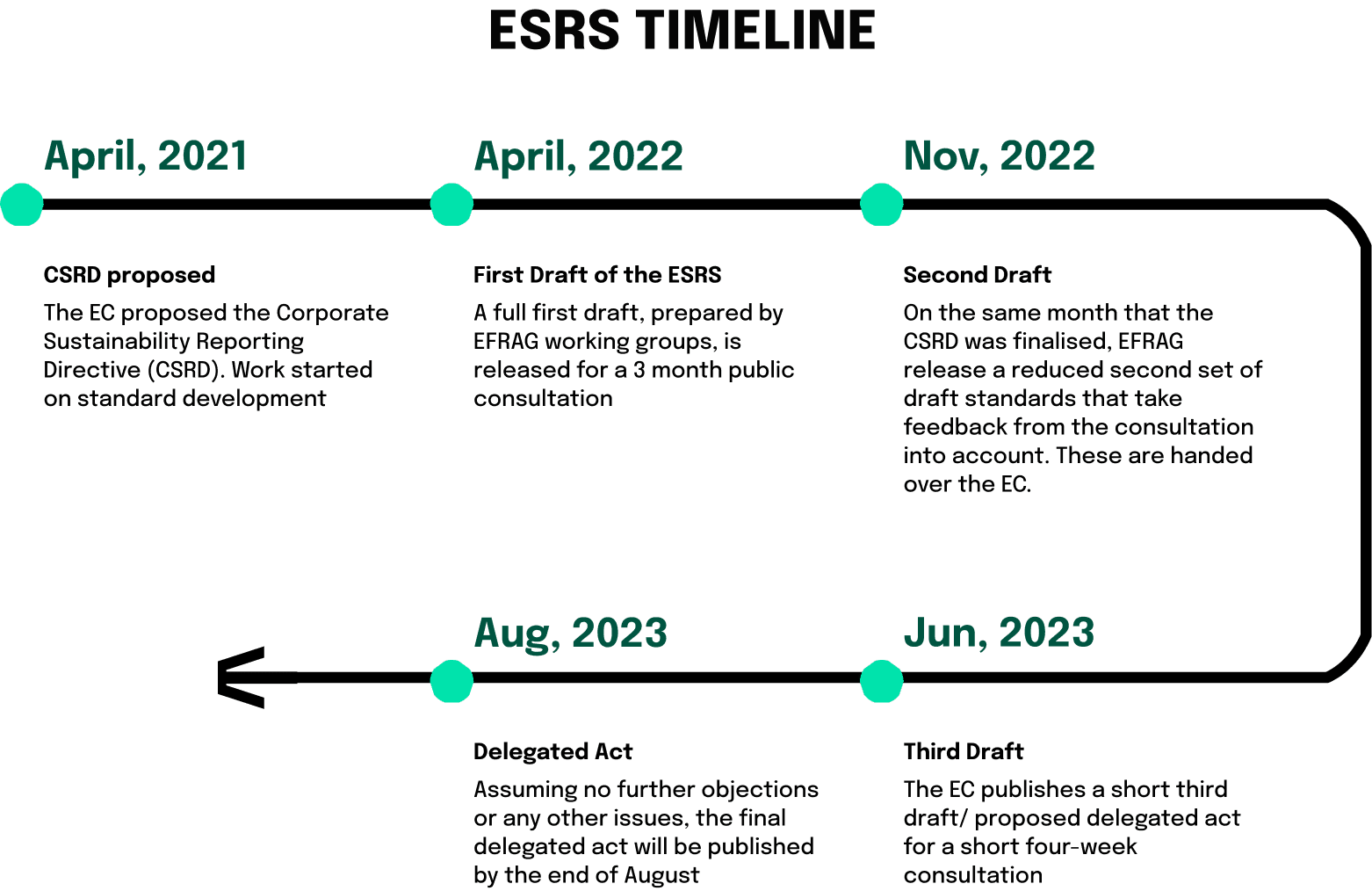
The establishment of the CSRD reflects the culmination of decades of progressive policymaking in the EU, recognizing the interconnectedness of economic, social, and environmental factors.
It represents a concerted effort to integrate sustainability into the core of business practices, aligning with broader global efforts to foster responsible growth and development. As part of the final milestone of the CSRD, the European Commission has now published its proposed updates to the first draft of the ESRS.
The CSRD and the ESRS are intrinsically connected, forming a cohesive framework for sustainability reporting within the European Union. The CSRD sets out the legal requirements, mandating a broader range of companies to disclose detailed sustainability information, thereby expanding the scope of reporting. The ESRS, on the other hand, provides the specific standards and guidelines that companies must follow to comply with the CSRD, ensuring consistency and comparability across reports. Together, the CSRD and ESRS represent a unified approach to enhancing transparency, accountability, and sustainability in business practices.
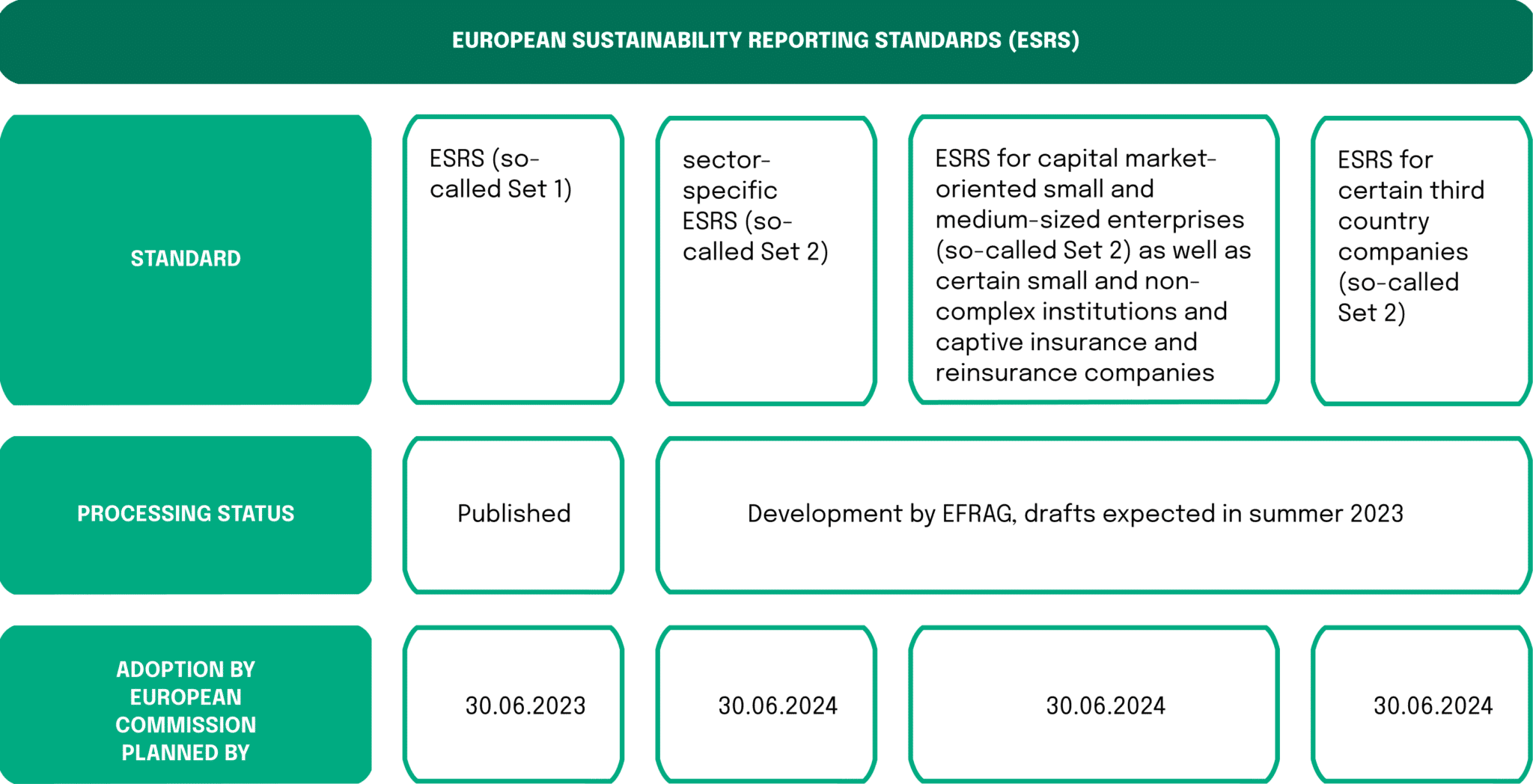
A closer look at the ESRS reforms
The ESRS is composed of 12 standards. Two cross-cutting standards provide general reporting concepts and include overarching disclosure requirements including multiple data points and reporting spheres. Ten topical standards complement these with detailed disclosure requirements across environmental, social, and governance topics. Together, these twelve ESRSs require companies to provide information on:
- their governance and strategy to address material sustainability topics;
- the impacts, risks, and opportunities arising from those topics; and
- quantitative metrics and targets.
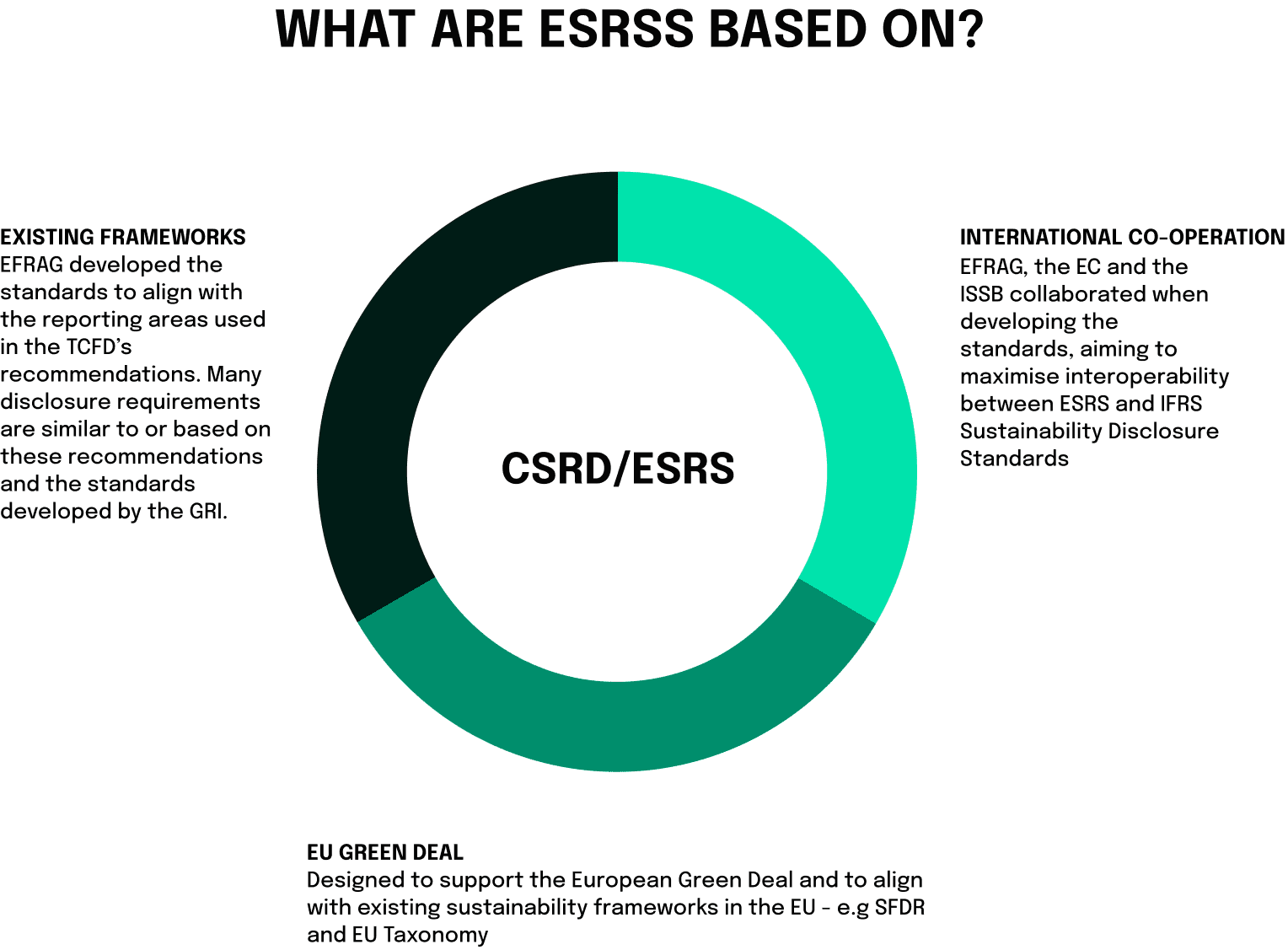
For the first wave of companies, disclosures will be required as early as the 2024 reporting period. However, it is not done with the first twelve standards. The following graphics provides a more visual representation of the interaction of the two cross-cutting and topic-specific standards.
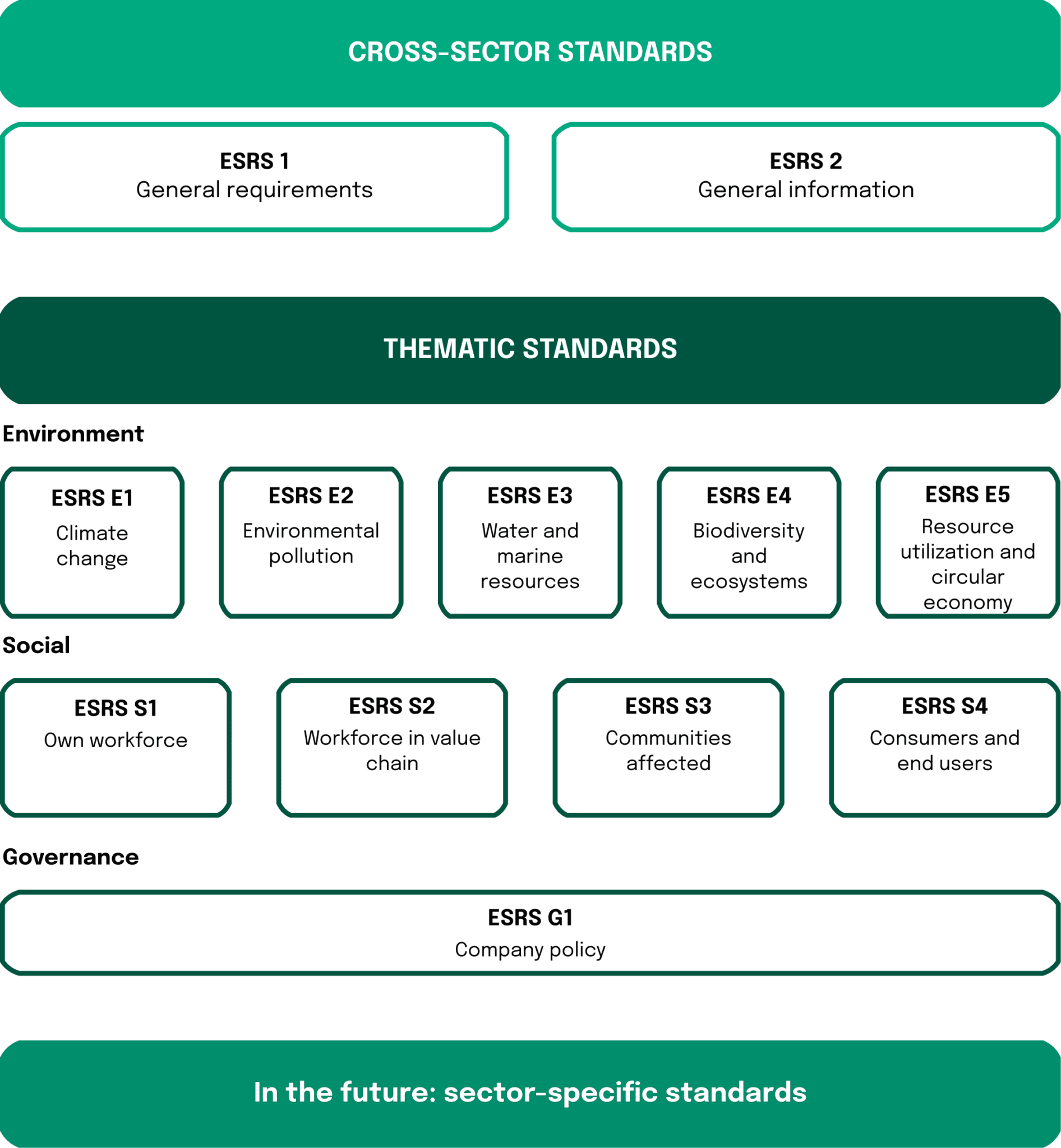
The implementation of the ESRS standards will create impactful changes based on:
- Enhanced transparency: One significant change in implementing the ESRS was the emphasis on greater transparency. For example, companies are now required to disclose not only their sustainability strategies but also the specific metrics and targets used to measure progress.
- Stronger focus on environmental and social factors: The standards cover an array of issues, from environmental, social, and governance (ESG) issues to climate change, biodiversity and human rights. Companies are now required to not only publish financial data, but also take broader ESG factors into account.
- Broader scope: The inclusion of smaller companies (with fewer than 250 employees) in the reporting requirements marked a shift towards broader accountability. This change aimed to capture a more comprehensive view of the industry’s sustainability efforts. Overall, around 50,000 companies will be affected by the ESRS standards.
- Increased availability of information: the new rules ensure that investors and other stakeholders have access to the information they need to assess the impact of companies on people and the environment and for investors to assess financial risks and opportunities arising from climate change and other sustainability issues.
- Harmonizing reporting standards: By harmonizing the ESRS standards with pre-existing reporting frameworks, the European Commission mentioned that the reporting costs will be reduced for companies over the medium to long term.
What will companies need to disclose?
But what exactly will companies need to disclose? The first topic is the environmental aspect of business, mainly reporting on climate change, pollution, water & marine resources, biodiversity & ecosystem, and resources use & circular economy. The second main topic is the social dimension of the business conduct focusing on the own workforce, workers in the value chain, affected communities and consumers and end users of the goods and services produced. The third major topic is governance where the companies must focus on reporting on their overall business conduct.
These three topics will be reported in four strategic areas:
- Governance: the ESRS requires disclosure on the governance of sustainability topics
- Strategy: it is required to highlight how the company incorporates sustainability into its business strategy
- Impact, risk, and opportunity management: disclosure on impact, risk, and opportunity management for areas that are assessed as material is required.
- Metrics and targets: specific sets of sector-agnostic metrics and targets will need to be disclosed for material topics.
As we already mentioned the topic of materiality twice in the four strategic reporting areas, we now need to take a look at the key features of ESRS to better understand the reporting requirements and characteristics of ESRS in detail.
The key feature of the first set of ESRS
The ESRS sets detailed reporting standards and requirements for companies under the CSRD. These requirements and standards can be summarized into seven specific characteristics of the ESRS, which we are going to present to give you an understanding of the extent to which companies need to report and justify their reporting.
- Double materiality principles: Double materiality refers to two dimensions of materiality, namely financial and impact. Companies will need to perform materiality assessments for both dimensions and report matters that are material in either dimension for all sustainability-related topics. So, this materiality assessment is a main component of the ESRS which in turn influences the extent of information and areas that need to be reported.
- Reporting across a broad range of topics: as we already mentioned in the previous sections, a lot of issues are covered under these new requirements. After the materiality assessment, companies need to ensure they have the data, processes, and expertise to report on topics that may be new to them, such as biodiversity or circular economy.
- Governance: Companies need to clearly set out their governance of how they address sustainability-related topics, including how sustainability key performance indicators (KPIs) affect remuneration. It might be the case that some companies must adjust their overall business strategy to incorporate more sustainability topics targeted by the ESRS.
- Reporting at the same time as financial statements: One major challenge of compliance in the future will be the quality and availability of data. Especially since companies in scope will prepare a sustainability statement including the disclosures required by the ESRS as a part of the management report, published at the same time as the financial statements.
- Reporting on impacts, risks, and opportunities across the value chain: As we highlighted in the graphic above, the new standards are closely aligned with the ESG factors and subsequently, the individual standards should cover a lot of these areas. Therefore, the ESRS requires companies to identify and report on impacts, risks, and opportunities from across the value chain.
- Reporting on policies, action plans, and targets: The new standards will shine a light on new aspects of planning for companies. It does not immediately require them to change their strategy, however, due to the high amount of new topics that need to be reported on, significant changes to policies, action plans, and targets might need to be implemented.
- Assurance: Companies need to be prepared for disclosures to be subject to assurance. This will require a clear audit trail and documentation of processes and controls.
Key changes compared to prior versions
The newly proposed standards by the EU have been open for discussion and comment over the last one and a half years. In the months leading up to the publishing of the ESRS, there have been some significant changes made to the regulatory requirements.
- Material and mandatory disclosures: Under the first set of ESRS, only ESRS 2 General Disclosures includes mandatory disclosure requirements. A list of mandatory disclosure requirements (i.e. disclosures not subject to materiality assessment) has been removed, in particular related to ESRS E1 Climate Change and ESRS S1 Own Workforce. Companies must have data points to report on all topics of materiality. Within the framework of the ESRS, E1 stands out with a specific requirement: if a topic within this category is assessed as not material, a detailed justification must be meticulously provided. Conversely, for all other topic standards, the guidelines offer more flexibility, allowing entities to briefly explain the conclusions of their assessment of materiality for the given topic. Of course, we will circle back to this change when we are talking about the critique of the current ESRS guidelines.
- Phase-in reliefs: as the ESRS will require significantly more areas that will be reported on, there are multiple phases in which the reporting will be implemented which can quickly be assessed in the following graphics. Additional to the implementation of the reporting requirements in steps, all companies may opt out of disclosing the expected financial impacts related to risks from environmental issues for the first year of reporting. Companies can provide qualitative disclosure only on these financial impacts for a further two years. For smaller companies (>750 employees) there are a few more facilitation in the first two years.
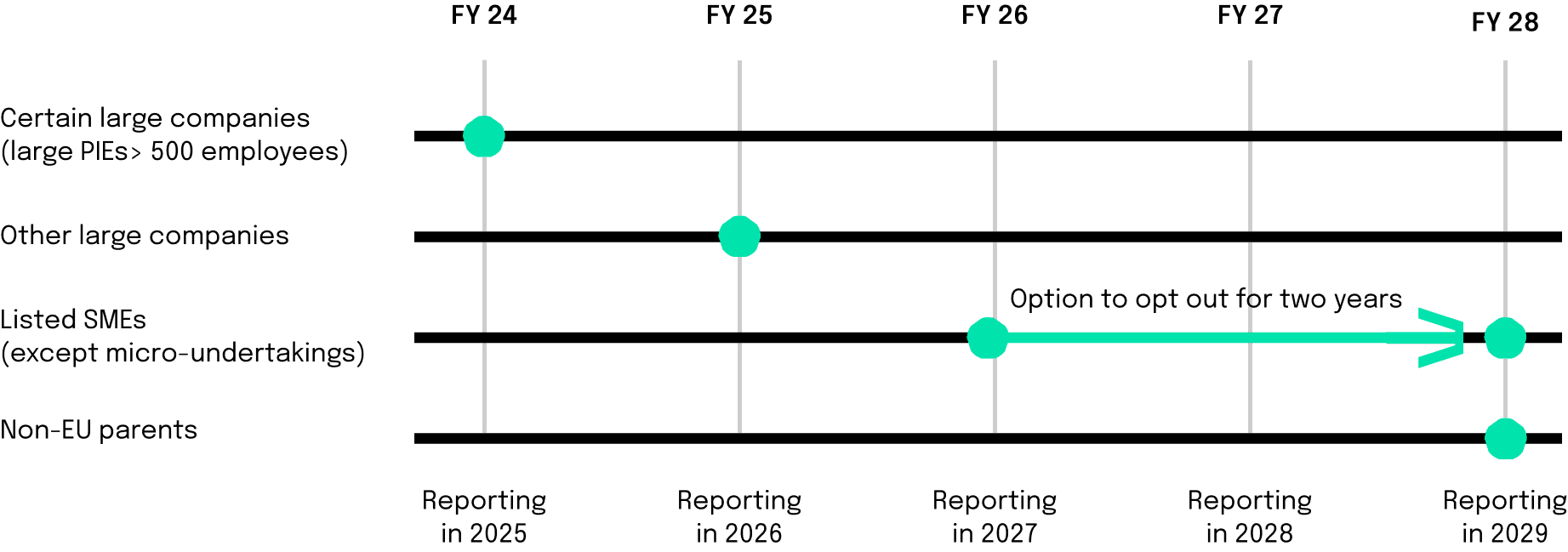
What impact will the ESRS have on businesses in the EU?
As the reporting requirements are broad and detailed, so will the impact of the ESRS be on the businesses that need to report on all the material topics in the future. As we have highlighted before, the new standards will require a large amount of accurate, detailed, and overall extensive information and data on all topics. This will be a huge challenge for companies since they do not only need to track their own workforce and practices but also need to observe the value chain of their products and services. Overall, reporting will get a lot more detailed and complicated for companies that did not need to report that extensively in the past.
The ESRS will put a spotlight on areas of business that other regulations have neglected in the past. Stronger focus on sustainability in the business strategy of all companies, a focus on ESG factors, and reporting on internal company policies will require some to reconsider their business practices.
What do companies need to do now?
We now have talked about the different areas of reporting, the characteristics of the ESRS, and the impact of the 12 new standards established. But what do companies need to do now? Especially since the bigger companies under CSRD already need to report on the ESRS requirements starting as early as next year!
- Understand the impact of ESRS: the first step must be an analysis of the impact of the new reporting requirements. How does the scope established by CSRD impact your reporting? How do the requirements established by the ESRS differ from existing frameworks? What parts of the value chain of your company will be included in the reporting? Where do you have data, what data is missing? All these questions must be answered.
- Determination of materiality: First, you must understand the scope and width of your value chain. Afterward, you must undertake a double materiality assessment to determine the topics that are material to your company which in turn will require reporting.
- Assessment of process quality: The next step must be an assessment of the quality of the reporting processes. We have highlighted the importance of data before, so this step must provide a clear understanding of the ease of data acquisition and the subsequent data quality as a basis for your reporting. Additionally, you should also understand and assess the quality and reporting knowledge and skills inside your company.
- Transform the reporting: If the processes analyzed in step three are incomplete, the reporting process must be transformed. This includes the design of the most efficient reporting structure to meet group, company, and value chain requirements.
- Get ready for assurance: A final assessment of data quality and materiality, as well as a check for sufficient documentation should conclude the steps to get ready for the ESRS requirements. This will prohibit any real issues throughout the formal assurance process.
ESRS and the finance industry
The introduction of the CSRD and the ESRS has ushered in a new era for the finance industry. Let’s delve into how these changes are influencing various facets of the sector.
For many banks and financial companies, the CSRD isn’t merely a regulatory hurdle; it’s a transformative opportunity. Here’s how:
- Investing with insight: Detailed reporting on sustainability performance opens up a new vista for financial institutions. It’s not just about numbers; it’s about aligning investments with sustainability goals, and fostering a transparent and responsible investment landscape.
- Managing risks, maximizing opportunities: Understanding sustainability risks isn’t just good practice; it’s essential for robust risk management. By recognizing and mitigating these risks, financial institutions can navigate a complex landscape with confidence and agility.
- Meeting the demand for sustainable products: Today’s customers and investors are savvy and values-driven. By aligning with the CSRD, financial companies can tap into this growing demand, offering products that resonate with a new generation of conscious consumers.
- Trust through transparency: Trust isn’t built overnight, and in the world of finance, it’s a precious commodity. By promoting sustainable investments and being candid about their practices, companies can forge lasting relationships with stakeholders.
- The ripple effect on non-financial companies: The ESRS’s reach extends beyond financial companies. Areas deemed non-material by non-financial companies might be vital for financial firms. Ignoring these areas might lead to reduced funding, as financial companies now face more rigorous reporting requirements.
In today’s business world, innovation is taking on a new dimension. It’s no longer just about inventing new products or services; it’s about a fundamental shift in the way companies operate, embracing new business practices, product paradigms, and even entire business philosophies.
The finance industry finds itself at the heart of this transformation. By strategically investing in companies that are not merely adapting but actively leading this change, financial institutions become more than investors; they become partners in progress.
The introduction of fresh reporting standards has provided the finance industry with a new perspective. These standards aren’t just rules to follow; they’re tools that enable financial professionals to discern which companies are genuinely driving innovation and positive impact.
This isn’t just a business opportunity; it’s a call to action. It’s about identifying, supporting, and growing those companies that are forging new paths, those that are committed to more than just the bottom line. By aligning with these pioneers, the finance industry is not only investing in promising businesses but also in a future where success is defined by responsibility, purpose, and transformative growth.
CSRD & ESRS and their impact on one’s sustainable business strategy
In the ever-evolving landscape of business, the CSRD emerges not merely as a regulatory mandate but as a beacon guiding companies toward a future where sustainability is at the core of strategy and success. Here’s how:
Transparency: A window into the future
- More than numbers: The CSRD extends its reach, compelling a broader spectrum of companies to report on sustainability. It’s not about ticking boxes; it’s about painting a vivid picture of performance, impact, and ambition.
- The strategy of sustainability: Gone are the days when sustainability was a buzzword. Under the CSRD, companies must lay bare how sustainability is intertwined with their strategy, vision, and values.
- Resilience in a changing world: The directive requires a holistic view of the business model, encompassing resilience to sustainability risks, alignment with global goals like the Paris Agreement, and a clear roadmap to a sustainable economy.
Building bridges: Stakeholders and sustainability
- A shared journey: Sustainability isn’t a solitary pursuit. The CSRD emphasizes collaboration, ensuring that stakeholder interests and sustainability concerns are woven into the fabric of corporate strategy.
- Amplified accountability: With annual reporting and transparent disclosure, companies open themselves to scrutiny and growth. It’s about trust, integrity, and a commitment to continuous improvement.
- Innovation and adaptation: The CSRD isn’t a static requirement; it’s a dynamic challenge. It nudges companies to rethink, adapt, and innovate, turning sustainability from a challenge into an opportunity.
A new era for corporate strategies
- Sustainability at the heart: The CSRD and ESRS are more than acronyms; they’re a philosophy. They urge companies to make sustainability a central part of their business practices, not an afterthought.
- Trust thanks to transparency: By shedding light on sustainability performance and practices, companies don’t just comply with regulations; they build lasting relationships with stakeholders, founded on trust and transparency.
The CSRD isn’t just about what companies do; it’s about why they do it. It’s a call to align business practices with a greater purpose, to see sustainability not as a constraint but as a catalyst for innovation, growth, and lasting success. In the end, it’s about forging a future where business and sustainability are not just aligned but inseparable.
What are the missed opportunities for the new changes?
The ESRS have arrived, heralding a new era of transparency and accountability in sustainability reporting. But like any significant change, the ESRS has not been without its critics. Let’s delve into some concerns and debates surrounding these new standards:
A shift from original intent?
Some experts have expressed concern that the finalized ESRS represents a dilution of the original drafts’ robustness. The question lingers: Have the standards lost some of their initial ambition and rigor?
Who’s accountable?
- The challenge of scale: By requiring only listed small companies (with fewer than 250 employees) to report under ESRS, have we missed a chance to broaden accountability? This limitation has sparked debate about whether the standards could have cast a wider net.
- A delayed start for some: The additional transition periods for companies with fewer than 750 employees, pushing reporting to 2026, have also raised questions. Is this a missed chance to foster early commitment among smaller companies, or a necessary concession to practicality?
The intricacies of materiality and comparability
- A complex landscape: ESRS, including E1, are governed by the materiality principle, ensuring that reporting aligns with the relevance and significance of sustainability topics. However, E1 is distinguished by a unique provision: in cases where this topic is deemed non-essential, a very detailed justification is mandated. If the entity concludes that climate change is not material, therefore, omits the disclosures required by the disclosure requirements in the ESRS E1 Climate Change, it shall disclose in detail the conclusions of its assessment of materiality with respect to climate change, including a forward-looking analysis of conditions that could cause the entity to consider climate change to be material in the future. This has added layers of complexity. For the other standards, an explanation of the exclusion is only an addition, which may lead to intransparency and incomplete reporting since non-mandatory topics aren’t as tightly governed by the ESRS.
- Biodiversity and the ESRS: a transition plan under scrutiny: Unlike other elements of the ESRS, this transition plan is not a mandatory part of the reporting requirements. Biodiversity is increasingly recognized as a vital component of sustainability, with far-reaching implications for ecosystems, economies, and communities. The lack of mandatory reporting on biodiversity transition plans within the ESRS has raised concerns about whether the standards are fully capturing the complexity and importance of this critical area. Critics argue that by not making the transition plan for biodiversity a compulsory part of the ESRS, an opportunity may be missed to drive more robust and transparent reporting on this essential aspect of sustainability. The absence of mandatory guidelines might lead to inconsistencies in reporting and a potential lack of focus on biodiversity-related risks and opportunities.
- A puzzle for investors: The potential impact on comparability, stemming from the choice of reportable topics based on materiality analysis, could ripple through the industry. This inconsistency might not only affect transparency but could also complicate investors’ decision-making processes. Within ESRS, there’s an aspect that has caught the attention of various stakeholders. It’s the provision that allows companies to gauge the relevance of their own activities, a flexibility that some find concerning. This concern stems from the possibility that companies might, whether intentionally or not, sidestep the disclosure of certain impacts that might be viewed unfavorably. It’s a subtle issue but one that could have far-reaching implications. For investors, this potential inconsistency in reporting could create challenges in comparing companies on a level playing field. When sustainability criteria are at the heart of investment decisions, a lack of uniformity in disclosure could introduce uncertainty and complexity. Moreover, this approach might ripple through to institutional investors and banks, affecting their ability to report accurately on the companies they invest in. This is especially pertinent given the EU’s Sustainable Finance Disclosure Regulation (SFDR), which emphasizes clear and transparent reporting on sustainability factors.
- Investing in a changing world: With restricted comparability, investors may find themselves navigating a more complex landscape, where assessing and comparing investment opportunities becomes a more nuanced task.
In the end, the ESRS’s success will depend on our collective ability to navigate these complexities, embracing the challenges as opportunities to refine and redefine how we approach sustainability. It’s a journey filled with promise and one that invites us all to be both critical thinkers and visionary leaders.
neosfer GmbH
Eschersheimer Landstr 6
60322 Frankfurt am Main
Teil der Commerzbank Gruppe
+49 69 71 91 38 7 – 0 info@neosfer.de presse@neosfer.de bewerbung@neosfer.de

